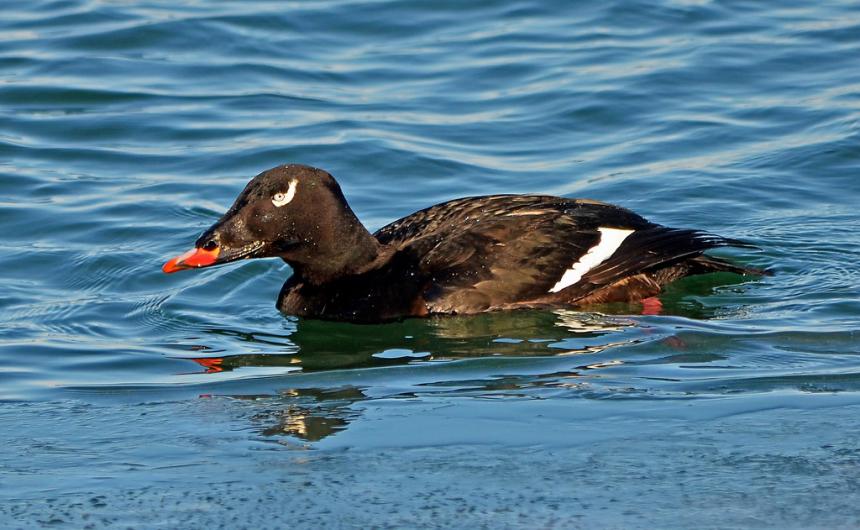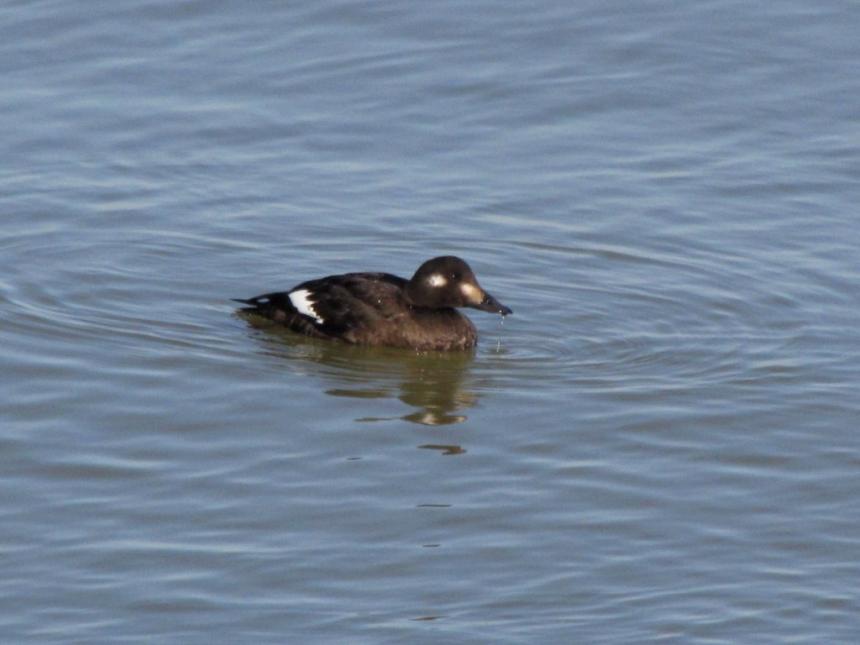Moderate
This sea duck species has low population numbers in Washington. The white-winged scoter has undergone significant population declines on Puget Sound, where it winters. Increasing development in the Puget Sound has led to more disturbance, pollution, and degradation of foraging areas used by sea ducks. Reduction of marine forage (primarily herring spawn) may be reducing populations in some areas. Some aquaculture practices can impact foraging areas through exclusion of sea ducks.
White-winged scoter is managed as a migratory game bird. Sea ducks are game species, managed under state and federal migratory waterfowl regulations cooperatively through the Pacific Flyway Council.
Description and Range
Physical description
The white-winged scoter is the largest scoter species in Washington. They are among the largest and heaviest of all ducks. White-winged scoters are about 21 ½ inches in length and weigh about 3 ½ pounds. They have primarily dark brown plumage and a white wing patch. Adult males have an orange beak with a black base, and have a small white patch under their eye; whereas adult females have a pale white ear patch and a pale white patch between their beak and eye. Immature birds are paler overall.
Like all scoters, these birds move along our coasts in loose flocks, stringing into irregular, wavy lines.
For more information on how to identify this species, check out the Sea Duck Joint Venture "Meet the Sea Ducks." Also check out the Resources section.
Ecology and life history
White-winged scoters first breed at two to three years old and the species are believed to be long-lived and have low recruitment in most years.
In spring, white-winged scoters move from saltwater wintering habitats to inland breeding areas in the boreal forests of northern Alberta and Northwest Territories. Many of their breeding areas are threatened by resource extraction and climate change effects. In some areas, white-winged scoters nest predominantly on islands, although gulls, common ravens, and American crows often destroy 10 to 30 percent of nests and a large number of ducklings. Birds depart coastal molting areas from late August through November.
In Washington, white-winged scoters spend most of their annual cycle on wintering areas in the Puget Sound area. Based on satellite telemetry studies by WDFW, adults have a high degree of site-fidelity to wintering sites.
Wintering white-winged scoters feed mostly on bottom-dwelling animals such as mollusks (clams, mussels, snails) and crustaceans (crabs, shrimp) at up to 66 feet in depth, before switching to herring eggs or other seasonally abundant prey during spring migration.
Geographic range
White-winged scoters have virtually disappeared from the more southern reaches of their breeding range in the prairie/parkland region of Canada and the U.S. Most white-winged scoters in Washington are found on Puget Sound during winter. Wintering numbers of all scoters on Puget Sound total approximately 50,000 and approximately 20 percent are white-winged scoters. The total scoter population index (three-year average) for Puget Sound has declined over 50 percent since 1994 to 1996, and they may have declined as much as 78 percent since 1978 to 1979. WDFW has implemented progressively restrictive hunting regulations for scoters since 1998 in response to population declines.
For maps of world-wide distribution and other species’ information, check out NatureServe Explorer and the International Union for Conservation of Nature Red List.
Climate vulnerability
Sensitivity to climate change
Moderate
Sensitivity of white-winged scoters to climate change is primarily driven by their dependence on coastal estuaries, bays, and open coastlines with shallow water over shellfish beds and/or sand or gravel bottoms for foraging. Changes in ocean temperature, water chemistry, or sea level rise that affect food supply or foraging habitats could impact this species. White-winged scoters are a late-nesting species and may also exhibit reduced flexibility in their timing of breeding, increasing their overall sensitivity to climate change.
Exposure to climate change
Moderate
- Increased ocean temperature
- Sea level rise
- Declines in dissolved oxygen and pH
Regulations
Rules and seasons
For current rules about hunting white-winged scoter in the state, be sure to check the Washington Game Bird and Small Game hunting regulations.
Conservation
Sea ducks are game species, managed under state and federal migratory waterfowl regulations cooperatively through the Pacific Flyway Council. The Pacific Flyway Council is an administrative body that forges cooperation among public wildlife agencies for the purpose of protecting and conserving migratory birds in western North America. The Council is composed of the director or an appointee from the public wildlife agency in each state and province in the western United States, Canada, and Mexico. Washington waterfowl hunters pursuing sea ducks in western Washington are required to record and report all harvest effort and activities, including for white-winged scoter.
WDFW has various game management plans to track populations and harvest of games species around the state, including waterfowl. These plans have information about harvest statistics from recent years, and the department's long-term vision and goals for a variety of species.
In early 2003, WDFW formed the Washington Waterfowl Advisory Group (WAG) to increase citizen involvement in the conservation and management of Washington’s waterfowl resources. This group has members from a broad representation of waterfowl hunters throughout the state. To learn about the WAG, contact the WDFW Waterfowl Section at (360) 902-2515 or visit the WAG webpage.
Conservation Threats and Actions Needed
- Resource information collection needs
- Threat: Lack of Information on status and distribution.
- Action Needed: Conduct annual winter inventory.
- Threat: Lack of information on population demography.
- Action Needed: Conduct periodic recruitment and species composition surveys.
- Agriculture and aquaculture side effects
- Threat: Some aquaculture practices can exclude sea ducks.
- Action Needed: Develop best management practices; identify and protect important foraging areas.
- Fish and wildlife habitat loss or degradation.
- Threat: Development impacts on breeding and wintering habitat.
- Action Needed: Document and address limiting factors.
See the Climate vulnerability section for information about the threats posed by climate change to this species.
Our Conservation Efforts
Midwinter Aerial Seabird Surveys
WDFW conducts survey flights over a period of several days from November through February annually to monitor the abundance, trends, and distribution of sea ducks and other marine birds in the Puget Sound and the Strait of Juan de Fuca (U.S. portion of the Salish Sea). Learn more about this research on the project's page.
Resources
References
Sea Duck Joint Venture Species Fact Sheet – White-winged Scoter
WDFW. 2013. Washington Sea Duck Management Strategies - Draft Report to the Washington Fish and Wildlife Commission.16 pgs.
WDFW publications
Other resources
- U.S. Fish and Wildlife Service - Overview: White-winged Scoter
- U.S. Fish and Wildlife Service - Aerial Observer’s Guide to North American Waterfowl
- U.S. Fish and Wildlife Service - Ducks at a Distance: A Waterfowl Identification Guide
- Sea Duck Joint Venture - A Conservation Partnership under the North American Waterfowl Management Plan
- Cornell Lab All About Birds - White-winged Scoter
- eBird Northwest – White-winged Scoter

